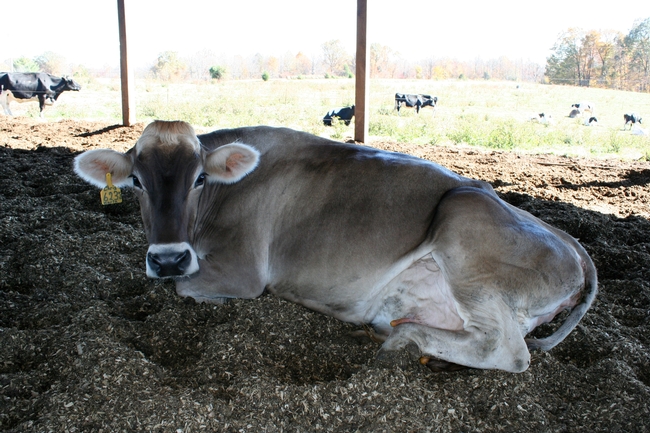Is Compost Bedding Pack right for your dairy? 
Compost bedded pack (CBP) barns are an increasingly popular open barn design for housing dairy cattle, particularly with funding opportunities available through the California Department of Food and Agriculture's Alternative Manure Management Program. These barns allow natural resting positions and offer shelter with a reduced infrastructure cost compared to traditional freestall barns. However, proper barn design and excellent daily management are essential for successful composting and to avoid negative animal health outcomes. A successful CBP begins with three key principles: bedding, stocking density, and air flow.
Bedding
In a CBP barn, bedding is more than an absorbent lying surface for your cows. Bedding acts as the carbon source, or essentially food, for the microorganisms within the composting bed. Before deciding to construct a CBP barn, consider where and at what cost you can acquire a continuous supply of bedding material. A mixture of kiln-dried sawdust and shavings remains the “gold standard” for CBP bedding. Other bedding alternatives exist, though may require more frequent additions and result in less efficient composting. Moisture content (and not time) determines when additional bedding needs to be added. The CBP should be between 45 and 55% moisture. To quickly test moisture, grab a handful of compost material and squeeze it. If water drips out of the ball, the CBP is too wet and you should add more bedding. If the material cannot form a ball, the CBP is too dry and you can wait before adding more bedding.
Stocking Density
Animal numbers can fluctuate on a dairy. A CBP is not always forgiving to those fluctuations. Stocking rates in a CBP are driven by the urine and fecal outputs of the cows. Producers should aim to provide 125 to 150 square feet per Holstein cow. Smaller framed cows, such as a Jersey, require less space. Overcrowding the barn results in too much moisture, dirty cows, and potential for udder health consequences. High stocking rates can also pack down the CBP, restricting air flow to the microbes and reducing composting efficiency. When planning the foot print of the barn, design for the peak number of animals and not the average to ensure adequate space year round.
Air Flow
The aerobic composting process requires oxygen. Adequate air flow is not only important for cow health and comfort but also to feed air into to CBP. Designing the barn with high side walls and fans provides natural and mechanical ventilation. Proper ventilation ensures microbes are supplied adequate oxygen essential for proper composting. Limiting the air available to microbes can reduce or stop composting. Twice daily stirring of the pack (without fail!) is also essential for composting success. A field cultivator accomplishes deep aeration (10-12”). A rototiller provides more shallow aeration (6-8”) with more breakdown of larger compost chunks and a more uniform surface.
Key Points
- Is there a source of year round bedding material which is affordable and consistent?
- Add additional bedding based on CBP moisture content
- Provide 125 to 150 sq. ft. per cow (Holstein; less for Jersey)
- Design the barn for peak animal numbers
- Stir the pack twice daily, without fail!
- Ventilate barn with natural and mechanical ventilation to ensure aerobic environment for composting
Questions about CBP barn design and management? Contact Randi Black at (707) 565-2648 or rablack@ucanr.edu